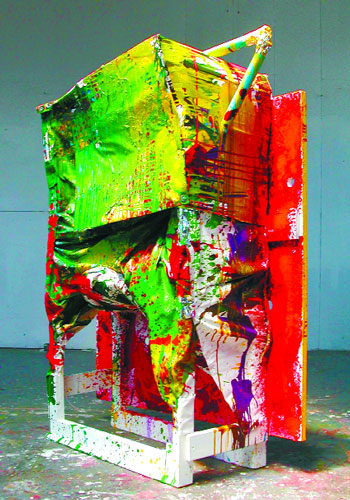Edouard Prulhiere’s premiere solo show evokes early investigations of post-war consumerism
“Novice Blunder,” French artist Edouard Prulhiere’s first solo show at Bellwether Gallery in Williamsburg, consists of seven pieces that buoyantly continue the exploration of what painting might be.
Rough, elegant work constructed of draped canvas, lumber, and ready-mades ambush the viewer’s assumptions both about the physical concerns of painting when thought of as an object and about its traditional two-dimensionality. Trafficking heavily in notions of the unbridled id that are dear to Abstract Expressionism and the CoBrA movement, Prulhiere also brings an infectious enthusiasm to his painterly investigation.
“Sex Was on Everyone’s Lips” is jerry-rigged onto a frame built from raw 2 x 4s that simultaneously suggest an easel, a baby’s high chair, and a standing figure. Cut pieces of sloppy, vibrantly colored canvas are repurposed as both stuffing and covering for a casually built armature. Although the paintings solidly inhabit the realm of non-objective abstraction, a human presence is felt in the scale of the pieces as well as in the way they seem to “face” us, evoking a wacky domestic or ritualistic utility. Paintings get plumped up into bedrolls, whoopee cushions, and voluminous grandma handbags; they fall, banner-like, from wooden clothes hangers or get bolted onto freestanding “crates.”
Prulhiere’s presence as the maker is strongly felt––one can almost see the ecstatic artist as shaman and cannibal slashing away at his own paintings, manically attaching them to anything and everything in his studio. In “2 of 30,” a pair of funky frames built of both traditional stretcher bars and crown molding meld into a single construction that slouches against the wall. Juicy and splattered canvases seem to be literally “scooped” out of their stretchers to further expose the painting’s innards. The resulting deconstructed/reconstructed object is breezily punctuated with a swirl of molded brown resin reminiscent of an adolescent gag gift, the pile of plastic doggie doo.
During the late 50s and early 60s, countrymen of Prulhiere’s, the Affichistes, tore apart and reassembled posters advertising the burgeoning consumer culture of post-war France, questioning the parameters of “high” and “popular” art, the role of the artist as singular genius, idiot savant, or vandal as well as ideas of originality and reproduction. In Italy, artists of the Arte Povera movement rudely punctured their canvases and canned their own shit for the consumption of art collectors. Simultaneous investigations by American artists––Robert Rauschenberg’s “combines,” Lee Krasner’s collage paintings, and Claes Oldenburg’s enormous soft sculptures of mundane objects––similarly probed the high/low nexus and the objecthood of painting.
Prulhiere’s unabashed homage to this rich period of art history is embodied in his heady collection of painted constructions. Enjoy the feast.



































